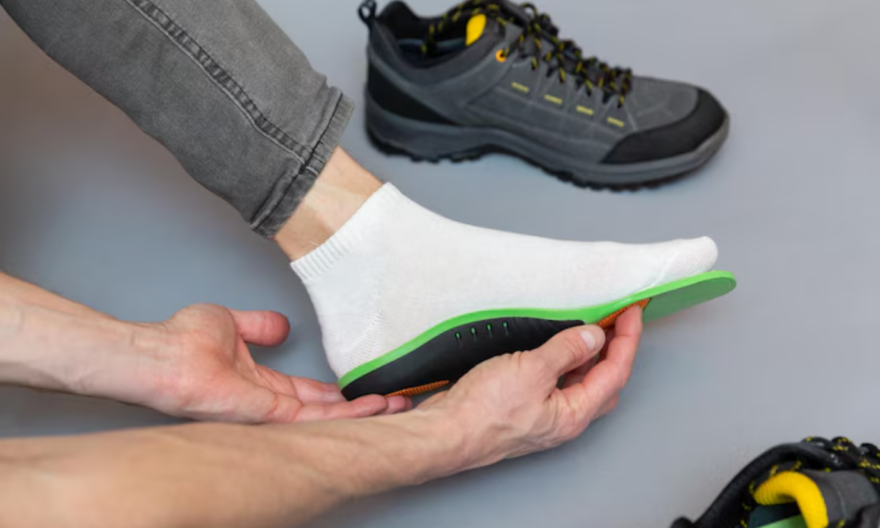
Running with high arches brings strain. Each step slams pressure into your feet, ankles, and knees. Without the right support, runners with high arches feel sharp jabs or dull aches. Over time, these pains grow worse. They creep into daily life and wear down your will to train. But with the right insole for high arch, runners in Singapore can push further without pain.
Understand the Shape of a High Arch
Your foot’s arch works like a spring. It absorbs shock and helps balance your stride. A high arch lifts too far off the ground. This shape causes most weight to press on the heel and ball of the foot.
Whether the Insole for flat feet presses down too much, or high arches curves too sharply. This shape reduces contact with the ground and adds stress to bones and muscles.
Most high-arch runners experience:
- Heel pain after long runs
- Calluses near the ball of the foot
- Strained ankles or shin splints
You may also notice your shoes wear out unevenly. The heel might cave inward or outward from the added pressure.
The Problems Runners Face in Singapore
Singapore’s hot and humid climate creates more problems for high-arch runners. The heat softens running shoes. As they bend and break down, shoes lose the firmness needed to support your arches. Looking for the best running insoles for high arches in Singapore is not too easy.
In addition, urban paths bring hard surfaces. Pavements and tiled parks press back with force. For runners with high arches, each step sends shock waves through the feet and legs.
Add in Singapore’s fast pace and dense city routes, and it’s clear why high-arch runners often feel defeated. But don’t hang up your shoes just yet—there’s a simple fix.
The Right Insole Makes All the Difference
Most running shoes come with thin, weak liners. These liners flatten fast and give no structure. A proper insole provides targeted support to lift your arch and spread pressure across your foot.
Unlike an insole for flat feet, which cushions a low curve, high-arch insoles hold the foot up and guide motion. They firm up weak spots and soften pressure points. The best insoles do four key things:
Support the Arch
High arches need structured lifts. A strong insole stops the arch from falling too far. This relieves strain from the heel and ball of the foot.
Cushion Shock
Foam or gel pads absorb force. Good insoles spread impact so no one part of your foot bears too much stress.
Align the Heel
A deep heel cup locks the heel in place. It stops the foot from shifting and keeps your stride straight.
Fit Inside the Shoe
A well-shaped insole fills space without squeezing. It should sit firm and stay still during long runs.
What to Look for in Running Insoles
You want the best running insoles for high arches in Singapore. Choose ones that match your shoe type, running surface, and daily distance. Think about these key traits:
Firm, Not Hard
Soft foam feels good at first, but it breaks down fast. Firm foam or plastic lasts longer and gives better support.
Moisture Control
Singapore’s heat creates sweat. Choose insoles with breathable layers. Dry feet prevent blisters and discomfort.
Arch Height
Match the insole to your arch height. Too low offers no lift. Too high can push your foot the wrong way.
Heel Design
Choose a narrow heel cup, it gives a better grip. Deep curves hold your heel in place and cut down strain on the Achilles.
Try your insoles with the shoes you use most. They should not crowd your toes or lift your foot too high. Walk in them first. Then run short distances. Adjust slowly so your body adapts to the new support.
Benefits of Arch Support in Singapore’s Climate
Singapore runners battle heat, rain, and concrete. Insoles reduce wear and tear in these tough conditions. Here’s how the right pair helps:
Protects Your Feet on Hard Pavement
Proper insoles absorb impact from stone paths and roads. They help you run longer without sharp pain or bruising.
Keeps Feet Stable in Wet Weather
Support reduces foot roll and wobble. This means better grip when it rains and fewer slips or twists.
Stops Muscle Fatigue
With firm arch lifts, your feet work less. You finish runs with more energy and feel fewer aches.
Lasts Longer in Humid Air
High-quality insoles resist the breakdown caused by moisture. They keep their shape even after weeks of wear.
Comparing Insoles: Flat Feet vs High Arches
Easy to confuse the needs of flat feet and high arches. Both types feel pain. Both need support. But the shapes and solutions differ.
| Feature | Insole for Flat Feet | Insole for High Arch |
| Arch Shape | Low and wide | High and narrow |
| Goal | Raise the arch | Support the raised arch |
| Pressure Points | Mid-foot | Heel and forefoot |
| Cushion Placement | Mid-sole | Ball and heel |
| Risk Without Support | Overpronation, knee strain | Underpronation, shin splints |
By choosing the right insole for your arch type, you avoid the trap of treating the wrong problem.
How to Know You Chose the Right Insole
Your feet will tell you. The best insoles feel natural. They don’t pinch or press. Instead, they lift your arch, ease your heel, and let your stride flow.
Look for signs like:
- Less pain after long runs
- Reduced soreness in the morning
- Fewer blisters and calluses
- Shoes wear out over time.
You feel more balanced and strong; the insole works. When pain shifts or worsens, check the fit again. Not every insole suits every shoe or foot shape.
When to Replace Your Running Insoles
Even top-quality insoles wear out. Swapping them on time prevents fresh injuries and keeps your stride smooth.
- Every 6–12 Months: Regular runners in Singapore’s climate need frequent replacements.
- Visible Cracks or Folds: Damaged insoles can’t provide firm arch support.
- Odour Build-Up: Persistent smells signal moisture damage and material breakdown.
- Loss of Shape: Flattened areas mean reduced support and poor shock absorption.
- Return of Pain: If foot aches return, your insoles likely need changing.
Stretches That Help High-Arch Runners
Supportive insoles do wonders, but regular stretches add long-term relief. They loosen tight foot muscles and reduce running strain.
- Calf Stretch: Press your heel down while leaning into a wall to ease heel tension.
- Toe Spread: Lift and spread your toes wide to build arch control.
- Foot Roll: Roll a cold bottle underfoot to soothe sore spots.
- Plantar Stretch: Pull back your toes while seated to stretch your arch directly.
- Heel Raises: Rise up and down slowly to strengthen arch support muscles.
Don’t Let Pain Cut Your Runs Short
You trained hard. You mapped your routes. You pushed past sweat and strain. Don’t let foot pain steal your progress. The right insole doesn’t just support your foot—it backs your whole journey.
Start with one pair. Test it on your regular runs. Give your body a week to adjust. You’ll feel the shift. Pain fades. Stride improves. Your runs go longer. And your love for running returns.
Even better, your feet thank you—not with blisters or aches, but with strength.
Final Thoughts
High-arch runners in Singapore face a tough mix of terrain, heat, and stress. But relief lies just underfoot. With a strong insole for high arch, your stride smooths out, your pain fades, and your passion for running grows.
Not every insole fits every foot. Choose wisely. Test slowly. And always trust what your feet tell you. Support makes the difference between injury and endurance.



